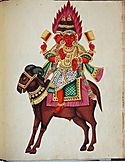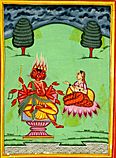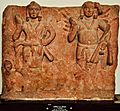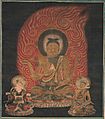Agni facts for kids
Quick facts for kids Agni |
|
|---|---|
| God of Fire | |
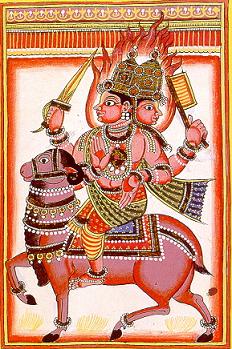
Agni upon his mount, with flames leaping upwards from his crown
|
|
| Other names | Mātariśvan |
| Affiliation | Deva, Dikpāla |
| Abode | Agniloka |
| Mantra | Om Agni Vidmahe |
| Weapon | Āgneyāstra |
| Mount | Urial |
| Personal information | |
| Consort | Svāhā |
| Children | Pāvaka, Pāvamāna, Śuchi, Nīla, Agneya |
| Parents | Brahma |
| Equivalents | |
| Greek equivalent | Hephaestus |
| Roman equivalent | Vulcan |
Agni (Sanskrit: अग्नि) is the Hindu god of fire. He is a very important god in the Vedas, which are ancient Hindu texts. In fact, he is considered one of the most important gods after Indra.
Agni can appear in three forms: fire, lightning, and the Sun. Because of this, he is often shown with three heads or three legs. Sometimes, he wears a garland of fruits or flowers. You can often find statues of Agni in the southeast corners of Hindu temples.
Agni also represents the natural element of fire itself. Hindus believe that fire, along with sky, water, air, and earth, makes up everything around us.
As a symbol of fire, Agni is used in many ways. It can mean the "fire" of digestion in your stomach. It also refers to the cooking fire in a home, the special fire used in religious ceremonies, and the fire used for cremation. It even represents the idea of rebirth.
Hindus believe there are three kinds of Agni inside every person. These are the "fire of anger," the "fire of desire," and the "fire of digestion."
Contents
Who is Agni?
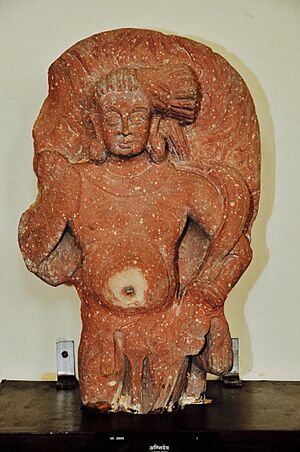
Ancient Hindu texts say that the universe began with nothing. Then, a being called Prajāpati (also known as Brahman) created Agni from his forehead. When Agni appeared, light came into being, and with light came day and night. Agni is seen as the eye of the universe.
Agni was one of the three main gods in early Hindu beliefs. His twin brother Indra was the god of storms, rain, and war. Sūrya ruled the sky and heavens. Agni, on the other hand, ruled the earth.
Agni's Family
Agni's wife is the goddess Svāhā. Her name is spoken when people offer things like butter and seeds into a sacred fire during ceremonies. Agni and Svāhā had a son named Skanda, who is known as the god of war.
Agni in Health and Food
Ancient Hindu medicine, called Ayurveda, saw Agni as very important for health. It was believed to be the life force in a healthy body. Agni was thought to be the power that helps us digest food. It also helps our bodies get rid of waste and harmful things. It even helps turn the food we eat into energy.
How Agni is Shown
The way Agni is shown in pictures and statues can be different depending on the region. He usually has one to three heads and two to four arms. He is often shown standing next to or riding a ram. A special feature is a dramatic halo of flames rising from his head. He looks like a strong man, sometimes with a beard. He has a large belly because he "eats" everything offered into his flames. His hair, eyes, and mustache are often golden brown, matching the color of fire.
In some parts of India, Agni holds a rosary (prayer beads) in one hand. This shows his connection to prayers. In his other hand, he might hold a sphere. In other regions, his four arms might hold an ax, a torch, a spoon (or a fan), and a flaming spear (or a rosary).
Agni's Importance
Agni plays a central role in many Hindu rituals. He is part of important life ceremonies. For example, a lamp is lit to celebrate a birth. Lamps are also used during prayers (called aarti). At weddings, the bride and groom walk around a sacred fire seven times. Agni is also part of cremation ceremonies. Hindus believe that Agni helps carry the soul of the dead from the fire to be reborn in the next life.
Images for kids
-
Agni is a part of the ritual grammar in many Hindu festivals. Above Holika for Holi, includes Agni.
-
Agni (right) with his son Skanda (Karttikeya), about 1st-century CE.
-
The Buddhist Fire God "Katen" (火天) in Japanese art. Dated 1127 CE, Kyoto National Museum.
See also
 In Spanish: Agni para niños
In Spanish: Agni para niños


